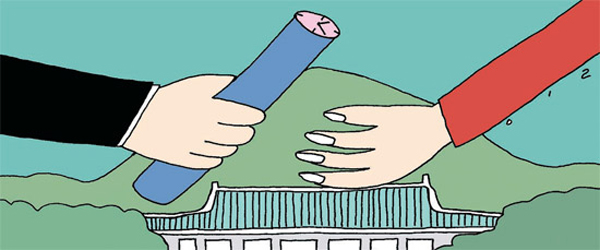Taking too long to transfer power

As a result, many pending issues have been postponed. Companies pushed back investment decisions as they weren’t sure about the industrial policies of the new administration. Financial authorities put off restructuring. Prices jumped as the force that suppressed them weakened. As if they were waiting for the end of the presidential election, gas and electricity prices went up. Those hikes affected all other commodities, with everything from kimchi to soju to going up by about 10 percent.
But we’ve all been here before. In fact, this situation has repeated itself every five years since the adoption of direct presidential elections in1987.
The two-month transition period was set in 1987, taking a page from the United States. What was the reasoning behind following the American example? Well, there wasn’t one. The Ministry of General Affairs at the time had sent a research team to Europe and America to survey administration transitions. As it was the first transfer of power to an elected government, they needed foreign examples. And they decided to follow the United States simply because it has the same presidential system.
So why do the Americans have a two-and-a-half month transition period? In fact, it was originally four months. Until the early 20th century, the inauguration of the U.S. president was on March 4, the day when the Constitution took effect in 1789. The time gap was necessary in the 18th century as the journey from the newly elected president’s home to Washington, DC, potentially required several months.
Four months was cut to two and a half because of a range of adverse effects. Lincoln couldn’t prevent the secession of the southern states and the Great Depression got worse because of the uncomfortable relationship between Franklin D. Roosevelt and his predecessor, Herbert Hoover. The end of the era of coaches meant far less travelling time. In 1933, a Constitutional amendment designated Jan. 20 Inauguration Day.
France and Japan, which have different systems, allow an even shorter period. In France, a new president goes to work about 10 days after the election. Even when the first power transfer was made in the Fifth Republic in 1981, Francois Mitterrand took office ten days after he was elected. It only takes a few days for a new Japanese prime minister to begin his job.
Park Geun-hye has now been inaugurated and her new administration has been launched. But her government is still unfinished. The government may not take shape until April. What has she been doing for 67 days? Why don’t we cut that period in half? There’s no reason to stick to transition procedures that impede the government from functioning. It’s time to do away with the old practice of wasting time and energy on transferring the baton, leaving the new leader exhausted by the time she has to start running.
*The author is an editorial writer of the JoongAng Ilbo.
by Yi Jung-jae










with the Korea JoongAng Daily
To write comments, please log in to one of the accounts.
Standards Board Policy (0/250자)